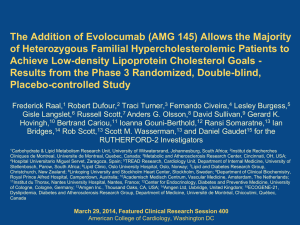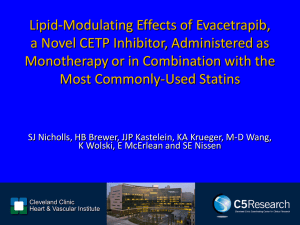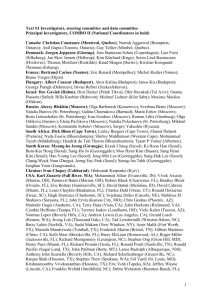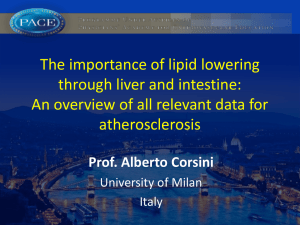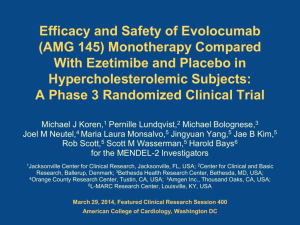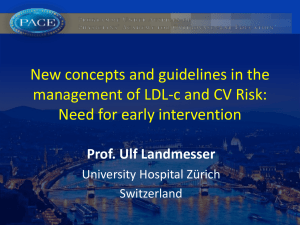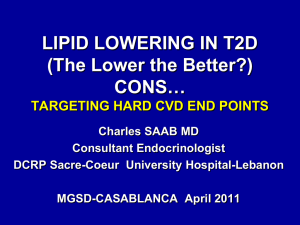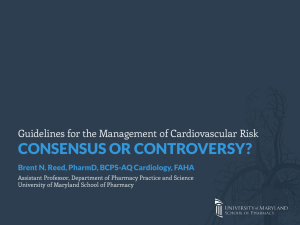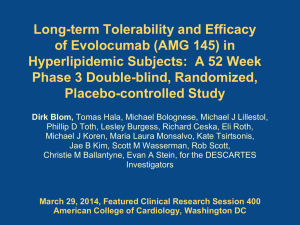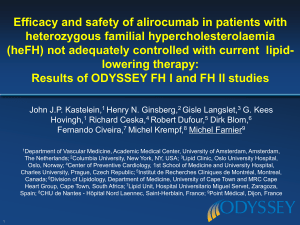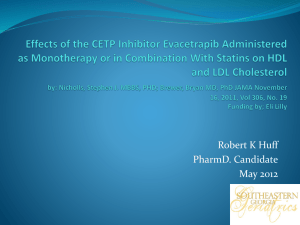Robinson_LAPLACE 2x - Clinical Trial Results
advertisement
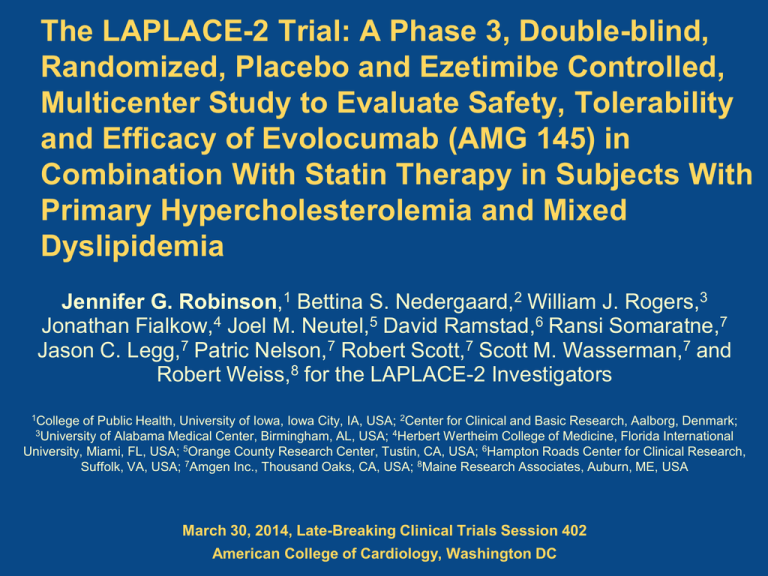
The LAPLACE-2 Trial: A Phase 3, Double-blind, Randomized, Placebo and Ezetimibe Controlled, Multicenter Study to Evaluate Safety, Tolerability and Efficacy of Evolocumab (AMG 145) in Combination With Statin Therapy in Subjects With Primary Hypercholesterolemia and Mixed Dyslipidemia Jennifer G. Robinson,1 Bettina S. Nedergaard,2 William J. Rogers,3 Jonathan Fialkow,4 Joel M. Neutel,5 David Ramstad,6 Ransi Somaratne,7 Jason C. Legg,7 Patric Nelson,7 Robert Scott,7 Scott M. Wasserman,7 and Robert Weiss,8 for the LAPLACE-2 Investigators 1College of Public Health, University of Iowa, Iowa City, IA, USA; 2Center for Clinical and Basic Research, Aalborg, Denmark; 3University of Alabama Medical Center, Birmingham, AL, USA; 4Herbert Wertheim College of Medicine, Florida International University, Miami, FL, USA; 5Orange County Research Center, Tustin, CA, USA; 6Hampton Roads Center for Clinical Research, Suffolk, VA, USA; 7Amgen Inc., Thousand Oaks, CA, USA; 8Maine Research Associates, Auburn, ME, USA March 30, 2014, Late-Breaking Clinical Trials Session 402 American College of Cardiology, Washington DC Background Statins are the first-line therapy for reducing atherosclerotic cardiovascular disease (ASCVD). 2013 ACC/AHA Cholesterol Guidelines1 A high-intensity statin (≥ 50% LDL-C lowering) is recommended for high-risk patients. • Clinical ASCVD; aged ≤ 75 y • LDL-C ≥ 190 mg/dL (4.9 mmol/L) • Diabetes; aged 40-75 years with ≥ 7.5% 10-y ASCVD risk A moderate-intensity statin (30-< 50% LDL-C lowering) is otherwise recommended. Non-statin therapy is recommended for high-risk patients who cannot tolerate a high-intensity statin, have a less than anticipated therapeutic response, or have genetic hypercholesterolemia. 1Circulation. Online ahead of print November 2013. 2 Background Outside of the USA, guidelines recommend an LDL-C <100 mg/dL or <70 mg/dL, depending on the level of risk.1-3 Many patients receiving moderate- or high-intensity statin therapy will require addition of another LDL-C lowering drug.4-5 Evolocumab (AMG 145) is a human monoclonal antibody to PCSK9. Evolocumab was well tolerated and showed robust LDL-C lowering in phase 2 trials,6-9 including a longer-term, 52-week study.10 1. Can J Cardiol. 2013;2:151-167. 2. Atherosclerosis. 2012;223:1-68. 3. J Clin Lipidol 2013;7:561-565. 4. N Engl J Med. 2005; 352:1425-1435. 5. JAMA. 2005;294:2437-2445. 6. Lancet. 2012;380:1995-2006. 7. Lancet. 2012;380:2007-2017. 8. JAMA. 2012;308:2497-2506. 9. Circulation. 2012;126:2408-2417. 10. Circulation. Online ahead of print November 2013. 3 The LAPLACE-2 Study LDL-C Assessment with PCSK9 MonoclonaL Antibody Inhibition Combined With Statin ThErapy – 2 (NCT01763866) Design: A 12-week, randomized, double-blind, placebo- and ezetimibecontrolled, phase III study Objective: To evaluate the efficacy and safety of evolocumab administered biweekly (140 mg) or monthly (420 mg) in combination with a statin in hypercholesterolemic patients 4 LAPLACE-2: Study Design Total N = 1896 Eligibility: LDL-C at screening ≥150 mg/dL (4.0 mmol/L): no statin ≥100 mg/dL (2.6 mmol/L): non-intensive statin ≥80 mg/dL (2.1 mmol/L): intensive statin *1896 patients were randomized and received at least one dose of study drug. LDL-C, low-density lipoprotein cholesterol; PBO, placebo; EvoMab, evolocumab; EZE, ezetimibe; PO, oral; Q2W, biweekly; QM, monthly; QD, daily; SC, subcutaneous; W, week. Clinical Cardiology. Online ahead of print January 2014. 5 LAPLACE-2: Baseline Characteristics Any Statin + Placebo (N = 558) Atorvastatin + Ezetimibe (N = 221) Any Statin + Evolocumab (N = 1117) 60 (10) 61 (9) 60 (10) Female, % 48 49 44 Coronary artery disease, % 22 17 24 Peripheral arterial disease or cerebrovascular disease, % 10 9 11 Diabetes mellitus, Type 2, % 13 20 16 Age (years), mean (SD) Total N = 1896* *1896 patients were randomized and received at least one dose of study drug. Baseline characteristics were collected at randomization to statin. SD, standard deviation. 6 LAPLACE-2: Baseline Lipids Any Statin + Placebo (N = 558) Atorvastatin + Ezetimibe (N = 221) Any Statin + Evolocumab (N = 1117) LDL-C,a mg/dL, mean (SD) 108 (40) 109 (37) 110 (42) ApoB, g/L, mean (SD) 88 (25) 90 (25) 90 (27) TG, mg/dL, mean (SD) 129 (66) 136 (77) 137 (82) HDL-C, mg/dL, mean (SD) 55 (17) 52 (15) 53 (16) Lp(a), mg/dL, mean (SD) 86 (100) 92 (104) 91 (113) PCSK9, ng/mL, mean (SD) 353 (114) 351 (112) 355 (111) Baseline characteristics were collected at randomization to statin. aDetermined by the Friedewald formula with reflexive testing via preparative ultracentrifugation when calculated LDL-C was < 40 mg/dL or triglycerides were > 400 mg/dL. LDL-C, low-density lipoprotein cholesterol; ApoB, apolipoprotein B; TG, triglycerides; HDL-C, high-density lipoprotein cholesterol; Lp(a), lipoprotein (a); PCSK9, proprotein convertase subtilisin/kexin type 9. 7 LAPLACE-2: LDL-C Response at Mean of Weeks 10 and 12 Mean Percent Change from Baseline in LDL−C Evolocumab Q2W & QM: 63 to 75% reductions in LDL-C versus placebo Ezetimibe: 19 to 32% reductions in LDL-C versus placebo Atorvastatin 80 mg Placebo Q2W Placebo QM Rosuvastatin 40 mg Atorvastatin 10 mg Ezetimibe QD + Placebo Q2W Ezetimibe QD + Placebo QM All treatment differences versus placebo and ezetimibe were statistically significant (P<0.001). No notable differences were observed between the mean of weeks 10 and 12 and week 12 alone. LDL-C, low-density lipoprotein cholesterol; Q2W, biweekly; QM, monthly. Vertical lines represent 95% CIs. Rosuvastatin 5 mg Simvastatin 40 mg Evolocumab Q2W Evolocumab QM 8 LAPLACE-2: Screening, Baseline, and On-treatment LDL-Ca LDL-C < 70 mg/dL: Moderate-intensity statin Q2W 88 to 94%; QM 86 to 90% LDL-C, mg/dL LDL-C < 70 mg/dL: High-intensity statin Q2W 94%; QM 93 to 95% aMean of weeks 10 and 12. No notable differences were observed between the mean of weeks 10 and 12 and week 12 alone. LDL-C, low-density lipoprotein cholesterol; lSP, lipid-stabilization period; Q2W, biweekly; QM, monthly. 9 LAPLACE-2: Other Lipids at Mean Weeks 10/12 Non-HDL-C Mean Percent Change from Baseline Q2W –58 to –65% vs placebo ApoB Q2W –51 to –59% vs placebo Atorvastatin 80 mg Rosuvastatin Atorvastatin 10 mg Rosuvastatin 40 mg 5 mg Placebo Q2W Placebo QM Ezetimibe QD + Placebo Q2W Ezetimibe QD + Placebo QM Simvastatin 40 mg Evolocumab Q2W Evolocumab QM All treatment differences vs placebo and ezetimibe were statistically significant (P<0.05). Vertical lines represent 95% CIs. No notable differences were observed between the mean of weeks 10 and 12 and week 12 alone. Non-HDL-C, non high-density lipoprotein cholesterol; ApoB, apolipoprotein B; Q2W, biweekly; QM, monthly. 10 LAPLACE-2: Other Lipids at Mean Weeks 10/12 Q2W –21 to –36% vs placebo Mean Percent Change from Baseline Lipoprotein (a) Atorvastatin 80 mg Rosuvastatin 40 mg Atorvastatin 10 mg Rosuvastatin 5 mg Simvastatin 40 mg Treatment Arm Placebo Q2W Placebo QM Ezetimibe QD + Placebo Q2W Ezetimibe QD + Placebo QM All treatment differences vs placebo and ezetimibe were statistically significant (P<0.05). No notable differences were observed between the mean of weeks 10 and 12 and week 12 alone. Vertical lines represent 95% CIs. Q2W, biweekly; QM, monthly. Evolocumab Q2W Evolocumab QM 11 LAPLACE-2: Safety and Tolerability n (%) Treatment-emergent AEs Most common AEsa Back pain Arthralgia Headache Muscle spasms Pain in extremity Serious AEs AEs leading to study drug discontinuation Deaths CK > 5 x ULN ALT or AST > 3 x ULN Potential injection site reactionsc Neurocognitive AEs Cognitive deterioration Disorientation Post-baseline binding antibodies a Top Any Statin + Placebo (N = 558) Atorvastatin + Ezetimibe (N = 221) Any Statin + Evolocumab (N = 1117) 219 (39) 89 (40) 406 (36) 14 (3) 9 (2) 15 (3) 6 (1) 7 (1) 7 (3) 4 (2) 5 (2) 6 (3) 3 (1) 20 (2) 19 (2) 19 (2) 17 (2) 17 (2) 13 (2) 12 (2) 1 (0.2) 2 (0.4) 6 (1) 8 (1) 2 (1) 4 (2) 0 (0)b 0 (0) 3 (1) 2 (1) 23 (2) 21 (2) 0 (0) 1 (0.1) 4 (0.4) 15 (1) 0 (0) 0 (0) 1 (0.5) 1 (0.5) 0 (0) 0 (0) NA NA 1 (0.1)d 5 in evolocumab treatment group. b One subject died after the end of study. c Reported using high-level term groupings which included injection site (IS) rash, IS inflammation, IS pruritus, IS reaction, and IS urticaria. d Binding antibody was present at baseline and at the end of study. No neutralizing antibodies were detected. 12 AE, adverse event; ALT, alanine aminotransferase; AST, aspartate aminotransferase; ULN, upper limit of normal. LAPLACE-2: Conclusions Evolocumab significantly lowered LDL-C at the mean of weeks 10/12 in patients with hypercholesterolemia on background statin therapy. There were no notable differences in percent reductions for moderate and high-intensity background statin therapies. Evolocumab 140 mg biweekly and 420 mg monthly dosing regimens are clinically equivalent. When combined with atorvastatin, LDL-C lowering was significantly greater in patients receiving evolocumab (63-75%) versus those receiving ezetimibe (19-32%). LDL-C < 70 mg/dL was achieved in most patients on evolocumab. 86-94% (moderate-intensity statin) 93-95% (high-intensity statin) There were no notable differences in safety & tolerability in evolocumab-, placebo-, and ezetimibe-treated patients. 13 FOURIER An ASCVD outcomes trial is underway Evolocumab Q2W or QM added to moderate or high intensity statin therapy Patients are those with clinical ASCVD (N = 22,500) The trial is evaluating atherosclerotic cardiovascular disease (ASCVD) event reduction and safety Further Cardiovascular Outcomes Research With PCSK9 Inhibition in Subjects With Elevated Risk (FOURIER). Available at: http://clinicaltrials.gov/ct2/show/NCT01764633. 14 Disclosures Jennifer G. Robinson, MD, MPH: Research grants to Institution: Amarin, Amgen, AstraZeneca, Daiichi-Sankyo, Esperion, Genentech/Hoffman La Roche, Glaxo-Smith Kline, Merck, Regeneron/Sanofi, Zinfandel/Takeda. Consultant: Amgen, Hoffman LaRoche, Pfizer, Sanofi. Robert Weiss, MD: PI for Amgen, Sanofi and Pfizer, and has received research grants in related areas from the following during the last year: Amgen, Sanofi, Regeneron, Pfizer, Genentech, Hoffman-Laroche, Eli Lilly, and Merck. Jonathan Fialkow, MD: served as a PI for studies sponsored by Amgen. Speaker's Bureaus for Pfizer, Bristol Myers Squibb, and Amarin Pharmaceuticals. Bettina S. Nedergaard: PI for studies sponsored by Amgen. Joel M. Neutel, MD: PI for multiple clinical trials. Speaker’s bureaus for multiple companies. David Ramstad, MD, MPH: PI for studies sponsored by Amgen, Pfizer, Bristol Myers Squibb, Novartis, GlaxoSmithKline, Takeda, Daiichi-Sankyo, Arete Therapeutics, Akros, Forest Research Institute, Lilly, Shire-Novartis, Hoffman-LaRoche, Aventis, and NovoNordisk. William J. Rogers, MD: PI for studies sponsored by Amgen and Sanofi. Ransi Somaratne, MD, MBA; Jason C. Legg, PhD; Patric Nelson, MPH, MBA; Robert Scott, MD; and Scott M. Wasserman, MD: employees of Amgen, Inc. and own Amgen stock/stock options. Amgen, Inc. provided editorial support for the production of this presentation. 15
